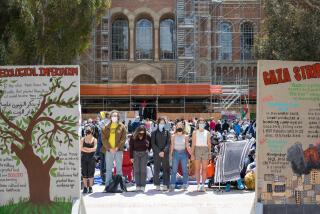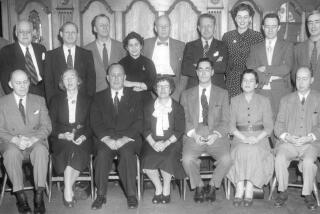WE NOW KNOW: Rethinking Cold War History.<i> By John Lewis Gaddis</i> .<i> Oxford University Press: 430 pp., $30</i>
Around the time Mikhail S. Gorbachev was about to become leader of the Soviet Union in the mid-1980s, John Lewis Gaddis had a clever idea. Looking at the Cold War as a period of extended superpower stability, he discovered not a war but “the long peace,” as he called it in a 1986 book of the same name. The term earned Gaddis a great deal of scorn. What about the constant confrontations? What about the countless people around the globe who had died directly or indirectly because of conflicts caused by the Cold War? Gaddis retorted that in the European context, conflicts of similar intensity before would doubtless have issued in actual war. The Cold War, then, prevented that from happening.
Gaddis’ celebration of the Cold War, this long period of stability, was, as it turned out, ill-timed. Gorbachev was about to end “the long peace,” and it obviously was a good thing he did.
Having written more than any other American historian about the Cold War, Gaddis, in his new book, “We Now Know,” sets out to assess what “the new evidence” from various Eastern archives suggests about the origins of that now suddenly vanished era of stability. His title suggests that now indeed we really do know, but readers expecting an inventory of great revelations will be disappointed. Another recent work, “The Cold War and Soviet Insecurity: The Stalin Years,” by Vojtech Mastny, addresses Stalin’s foreign policy more accurately with the succinct comment: “The greatest surprise so far to have come out of the Russian archives is that there was no surprise.” There is less here than meets the eye.
Gaddis is a first-rate historian who likes to synthesize and argue, not to compile. He is less interested in the “we now know” trope than in interpretive reassessments, where he has real novelty to offer. To be sure, there is new material about critical events that Gaddis, like all historians, reads in his own way. But the evidence is never self-evident. Thus, we get an intriguing account of the Korean War from the vantage point of the interplay between Joseph Stalin, Mao Tse-tung and Kim Il-Sung. Recent interpretations see that war as a civil war, but Gaddis unambiguously writes about the North’s attack on the South and the internal dialectic between the three communist leaders. Stalin’s green light to Kim and the subsequent anxieties and divergences on the communist side are detailed. This is valuable. It is “diplomatic history” of a gripping kind. But it is not the whole story. Stalin probably gave his permission only because he thought, erroneously but not unreasonably, that the United States considered Korea beyond the realm of its intervention. Making this into a “communist story” also reduces Korea once again to a simple staging area.
We also get a history of the Cuban missile crisis, about which one thought everything had been said. Not so. The enormous volume of testimonies about this crucial event is brought together by Gaddis and woven into a superb analysis of the various actors. Nakita Khrushchev’s missiles were not positioned merely for strategic balancing. They were put there as a measure of his strong support for the Cuban revolution. Even after their withdrawal, the Soviet leader always thought the confrontation had been successful because Khrushchev had prevented the expected destruction of Fidel Castro’s regime. Gaddis also accentuates, rightly, that John F. Kennedy, aware of the immense dangers and quite willing to compromise, was much more of a dove than commonly thought. On the paradoxes and ironies of nuclear weapons, Gaddis tends to be at his best, playing out the subtleties in a game that does not involve simple oppositions of good and evil.
Gaddis’ logic and ideological consideration of Germany is, by contrast, highly questionable in a way that is symptomatic of his book as a whole. Gaddis’ overriding story, however, is about American democracy fighting Soviet totalitarianism or, in Gaddis’ words, Soviet authoritarianism. In fact, this is less a book of revelations than an ideological one about ideology, an unabashed move to retell the old story of the Cold War as a struggle between good and evil. There can be no place for ambiguity within that frame. The “new evidence” would thus have to fit the frame exceedingly well to make the narrative convincing. This is where the problems begin. Take, for example, the central question of Germany in the immediate postwar period.
Gaddis gives the impression that Stalin had plans for the integration of Germany into the Soviet sphere of control and that Western policies and the ensuing division of the country were merely a function of that gambit. However, the most recent work on the subject concludes that the permanent division was a Western idea. Another account, otherwise intensely hostile to Stalin, says that he had no preconceived notions about Germany and was more interested in Poland. Gaddis chooses not to talk about what the Soviets generally found important in resolving the German imbroglio: denazification, demilitarization and decartelization on the one hand, reparations to the devastated Soviet Union on the other. These were not small matters for the Soviet leadership.
But Gaddis is not interested in such topics because he wants to push a different kind of story, in which the United States installs a democracy and the Soviet Union authoritarianism in their respective parts of occupied Germany. In doing so, they were merely reflecting their own domestic systems. American benevolence, says Gaddis, “reflected democratic culture.” Habitually alien to coercion, this culture allows for “a wider and more cacophonous range of voices” to “create a buffer against bullying, smoothing out disparities of raw strength and providing recourse against the arrogance these can bring.” All of which, supposedly, merely mirrors the stabilizing effects of “the free exchange of commodities.” I note these pleasing commonplaces chiefly for their rhetorical charge. It is atypical. Gaddis’ stylistic strength is usually his relentlessly reasonable tone, the seamless argument.
More interesting and controversial is Gaddis’ argument that Stalin and his cohorts (especially Mao) were not only authoritarians but also “romantics.” It is not an epithet that comes readily to mind when one thinks of Stalin. Nasty, brutish, cunning, lots of horrible things--but romantic? I think not. Gaddis seems to mean, however, nothing more than that Stalin really was a communist, doctrinally bound, and so not capable of seeing reality for what it was. The gap between Stalin’s actions and the “real” interests of the Soviet regime would otherwise be incomprehensible. Stalin was essentially led astray by his romantic attachment to communism. Later, in Khrushchev, for example, this romanticism, according to Gaddis, became a perverse sort of sentimentality, “geriatric overexertion” and a futile attempt to find revolutionary roots long since lost.
Ideology, it has been pointed out, is something the other guy does. Communists have ideology; Americans have “habits” and maybe some “ideas.” Curiously, in view of the explanatory importance he accords to it, Gaddis offers little analysis of Soviet ideology and Marxist-Leninist strategy. The only American who offers any ideology is John Foster Dulles, who appears in Gaddis’ chapter on the Third World, where the American leadership is taken to task for devils in places where none, or very few, were to be found. Dulles’ views on colonialism are described by Gaddis as a mixture of “American exceptionalism, Wilsonian internationalism, Christian moralism, geopolitical opportunism and historical determinism.” Good thing, then, that this busy body was kept largely under control by the much more sensible Dwight D. Eisenhower. Falling into Vietnam was “feckless stupidity,” but Gaddis says we should not criticize this policy too harshly. The “nightmares” seemed real at the time.
One might think there was something ideological, indeed even “romantic,” about the American mind that induced these nightmares. But what Gaddis is after in his muddled argument is not really romanticism or even ideology but the notion of utopian transcendence. Stalin, contrary to his realist appearance, turned out to believe in the ultimate transcendence of revolution and, thus imprisoned, he completely misread the West, which was interested in democratic benevolence.
What is wrong with this picture is not that Stalin thought history was on his side and that he misread the West. What is wrong is the idea that Stalin had one iota of utopian consciousness. As Jean-Paul Sartre argued long ago, Stalin understood Marxism-Leninism as a guide to action, a strategic frame. And the action was to preserve the Soviet Union and Stalin’s regime, which would serve the long-term interests of historical transformation and, theoretically, everyone on Earth. It was a course of action that required the utmost vigilance and ruthlessness. But it was not an offensive posture, and it did not exclude “deals” with the West. On the contrary, the whole edifice of Stalinist strategy was based on the idea of doing deals with “progressive” bourgeois parties and nations. There was nothing romantic in this approach, and it offered precious little utopian transcendence.
Reinventing the Cold War as the romantic ideology of the other side is reinventing the polarity of good and evil. It is also a deliberate return to the American orthodoxy of the 1950s. It is, perhaps, Gaddis’ atonement for his geopolitical sins in talking about the “long peace,” for talking in the apparently amoral language of neo-realism. One recalls, however, that Gaddis always thought Stalin had originated the Cold War through his extravagant security claims. Indeed, Gaddis now argues that, beyond the authoritarian romanticism of communist ideology, Stalin’s whole being embodied the very principle of the Cold War: He carried on a cold war even within his own family. The United States and the West, then, could never have concluded any acceptable agreements with such a dictator and regime.
It is enough to think ahead a few years in the narrative to see how implausible his position is. Precisely such a geopolitical arrangement was to be struck in China with a dictator whose revolutionary credentials were much more convincing than Stalin’s. In the early 1970s, American geopoliticians went to Beijing and paid homage to the enemy of their enemy, the very man who had unleashed the most astonishing case of revolutionary utopianism in the whole postwar era, namely, the Cultural Revolution. The American move worked, in the event, to the mutual satisfaction of both sides.
Yet the romantic-ideological argument has a deeper logic for Gaddis. Every explanation of the Cold War that centers on blaming Stalin has to face the simple fact that it was not in his interest. Enter, therefore, the theory of Stalinist blunders, in the form of excessive security demands, faulty ideological lenses, personal paranoia or all of the above. This is certainly arguable. In his crude reductionism and brutality, Stalin blundered a great deal. But he knew (on economic grounds if nothing else) how extraordinarily powerful the West was and that conflict was out of the question. One must ask, then, whether the Cold War was in the Western interest and, particularly, if there was something about the United States’ “security claims” and “ideological blinders” that might have seen the severance of diplomacy with the Soviet Union as a highly practical way of resolving the thorniest of all problems: the problem of how to get the United States finally into the postwar world on a sustained basis and to recast the vast preponderance of military-industrial strength in the world under its hegemony. The justification for this was readily available because of World War II. The world would not be secure until every criminal regime had been stamped out, and the United States would have to lead that struggle or fib. As utopian a vision as one will find anywhere, it was also enormously effective.
Gaddis now thinks the West had won the Cold War by the time of the Cuban missile crisis. The Soviet regime as a model was declining, if not dying. The West was winning. Peculiarly, it would take decades before anyone, Ronald Reagan actually, challenged the bankrupt Soviet regime. How could this be? The answer, of course, is that the Soviet Union still had the capacity to compete in military matters, especially in nuclear weapons. What might then be called “the fairly long peace,” can, after 1962, be attributed to nuclear weapons that preserved the Soviet Union abnormally long after its actual demise.
This view is wrong historically. The Soviet system entered its period of real stagnation only in the 1970s and could probably have tottered on for a long time. But Gaddis seems not to see where his logic is carrying him. If the military-industrial complex kept the Soviet Union in business, perhaps it had not been in the West’s interest to militarize Europe and build countless encircling alliances around the communist blocs in the 1940s and 1950s. When the Cubans (the only real adherents of what used to be known as “proletarian internationalism”) went to Africa in the 1970s to defend the revolution against South Africa and others, I recall Andrew Young shrugging it off. It didn’t much matter, he said, because in the end we make Coca-Cola and they don’t. He was American ambassador to the United Nations at the time and not the proud mayor of the City of Coca-Cola where the Coca-Cola Olympics recently took place. In the end, things would go better with Coke than with nukes. It was an outcome that not even such capitalist true believers as Ronald Reagan believed possible.
More to Read
Sign up for our Book Club newsletter
Get the latest news, events and more from the Los Angeles Times Book Club, and help us get L.A. reading and talking.
You may occasionally receive promotional content from the Los Angeles Times.








